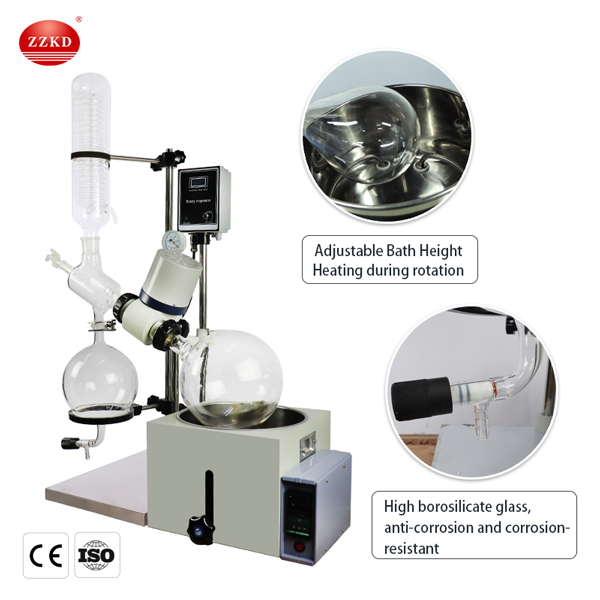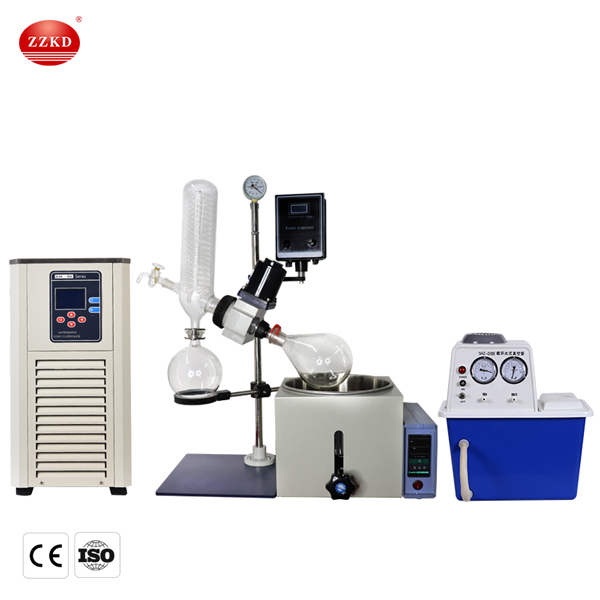Rotary Evaporator Chemistry
A rotary evaporator was used to remove solvent from the reaction mixture. They can be found in almost every organic lab because they can perform this task very quickly. A typical rotary evaporator has a water bath that can be heated in a metal vessel or crystallization dish. This prevents the solvent from freezing during evaporation. The solvent is removed in vacuo, collected with a condenser and collected for easy reuse or disposal.
The organic chemistry experimental instrument rotary evaporator chemistry is developed under the condition of vacuum and negative pressure, using the principle of constant temperature heating and thin film evaporation. The rotary evaporator chemistry uses stepless speed regulation to make the glass rotary bottle rotate at a constant speed, and the material forms a large-area uniform film on the bottle wall, and then the intelligent constant temperature water bath heats the rotary bottle evenly, evaporates at a high speed under vacuum conditions, and the solvent vapor is condensed through the high-efficiency glass The device is cooled and recovered in the collection bottle. The chemical rotary evaporator has the characteristics of large contact area, high evaporation efficiency, convenient use, low noise, reliable sealing, can handle easily foaming materials and complete specifications. At present, our company has formed 2L, 3L, 5L, 10L, 20L, 30L , 50L, 100L and other products in various specifications, which are convenient for customers in production. Let's introduce the use of rotary evaporator in chemical experiments.

Synthesis of peracetylated compounds:
The reaction was performed in a 20 L reactor under Ar atmosphere. To a stirred suspension of this peracetylated sugar intermediate (2.52 kg, 6.49 mol) in anhydrous DCE (4.0 L) was added slowly (10 min) TMSOTf (1.40 L, 7.74 mol) under Ar atmosphere. The mixture was stirred overnight at room temperature and transferred via transfer line to a vigorously stirred mixture of NaHCO3 (1.64 kg, 19.4 mol), ice (5.5 L) and water (5.5 L) in an open 40 L reactor. Stirring was continued for 40 min, the organic layer was separated, the aqueous layer was washed with DCM (x2), and the combined organic extracts were dried over anhydrous Na2SO4. The mixture was filtered, the solvent was evaporated, the oily residue was dried on a chemical rotary evaporator (15 mbar, 30° C.), redissolved in anhydrous DCE (4.0 L), and the solvent was evaporated again, and dried on a rotary evaporator (15 mbar, 30° C.). 3 mbar, 30°C bath temperature) to obtain 2.14 kg of crude pure compound peracetylated compound. The crude compound from the rotary evaporator was redissolved in anhydrous DCE (4.0 L) and the resulting pure compound was peracetylated.

Synthesis of Hydroxy Acid 23:
The reaction was performed in a 20 L chemistry rotary evaporator flask under a slow flow of argon. A solution of valerolactone 22 (98% purity (TCI), 1 kg, 10 mol) and triethylamine (140 mL, 1 mol) in anhydrous methanol (4 L) was stirred at room temperature for 1 h, during which time a slight evolution was observed. Thermal effects (up to 28°C). The mixture was concentrated in vacuo (25°C hot bath), diluted with anhydrous toluene (4 L), and evaporated under reduced pressure, and the residue was evaporated on a rotary evaporator chemistry at 4 mbar/25°C Drying followed by stirring overnight under high vacuum (0.4-0.6 Torr, room temperature) gave 23 as a colorless liquid, 1.39 kg (100%) containing
Synthesis of Compound Benzoylation:
The obtained perbenzoylated product (608g, 0.938mol), anhydrous LiI, 503g, 3.75mol), and a mixture of anhydrous pyridine (1.6L) were heated and refluxed gently for 24h, cooled to room temperature and diluted with water (0.5 L). Pyridine was evaporated, the oily residue was dried on a rotary evaporator chemistry at 4 mbar/30° C. 5L). The organic phase was separated with 5% aqueous NaCl (2 L), 3% aqueous sodium bisulfite (2 L), and dried over anhydrous Na2SO4. The solution (total volume 6 L) was decanted from the desiccant and filtered through a plug of 900 g of silica gel in ethyl acetate-hexane mixture (2:1 ) wet loaded on a sintered glass filter funnel. The silica gel cake was washed with AcOEt-hexane 2:1 mixture until no substantial amount of acid was observed in the filtrate by TLC (ISL). The combined filtrates were evaporated, the foamy product was dissolved in ACN (1.6 L), and the ACN was evaporated. The last procedure was repeated and the product was dried at 0.4 Torr for 1 day to obtain 25 (584.3 g, 98%).

Precautions for rotary evaporator chemistry:
1. If the vacuum cannot be pumped, check: whether the joints and interfaces are sealed; whether the sealing ring and sealing surface are effective. Whether the vacuum grease is applied between the main shaft and the sealing ring; whether the vacuum pump and its hoses are leaking; whether the glass parts are cracked, cracked or damaged.
2. Before installation, a layer of vacuum grease must be applied to each grinding port, sealing ring and joint.
3. Water must be added before the heating box is powered on, and dry heating without water is not allowed.
4. Screw into the safety hole to prevent damage to the flask.
5. The assembly of glass parts should be handled with care, and should be cleaned, wiped or dried before assembly.
Rotary evaporator chemistry is used in laboratory research, chemical production laboratory testing, medical testing, etc. Evaporation, concentration, crystallization, drying, separation, solvent recovery, etc. Indispensable equipment for the process.


